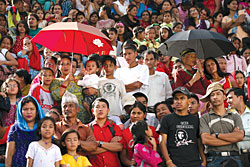 KIRAN PANDAY |
For a country that is supposed to have more deities than people, our overly fecund population will soon be overtaking non-mortals in number. And that may be the only thing certain about the census 2011.
The census, which will be conducted over two months next year by 80,000 enumerators, will be the most accurate census to date, says Rudra Suwal, Director at Central Bureau of Statistics (CBS). It is expected to cost over 2.7 billion rupees, most of which will be funded by donor agencies.
With state restructuring in the works, the new census will also be the most closely watched census in history. It is expected to show dramatic changes in the composition of ethnic, religious and urban populations.
"Due to the 10-year long conflict and economic reasons, people, especially from rural areas, have moved significantly. We know that population concentration is not what the politicians thinks it is," says Vijay Thapa, of the United Nations Population Fund (UNFPA).
The proportion of Hindu population, for example, may remarkably decrease in the new census, if not significantly. "Substantial number of people belonging to hill ethnic groups may possibly disassociate themselves from Hinduism, and affiliate to other religions like Buddhism, Kirat etc. Worshipping some of the so-called Hindu gods and goddesses does not necessarily mean that worshippers are Hindu, according to some ethnic leaders," says statistician Pawan Kumar Sen. Some Gurungs, for example, are devotees of local Debis (Hindu goddesses) but may not necessarily call themselves Hindus.
There will also be remarkable changes in the ethnic composition of population in the Tarai due to internal migration. Migrants from hill and mountains make up 85 percent of the total migrants, most of them moving to Tarai. Consequently, concentration of population in Tarai region will be higher than in the hills.
The most dramatic increase will be in the urban population projected to be between 20 to 30 percent of the total population in the new census. The number of people leaving rural areas stands at 30 percent, says CBS Director Suwal, one-third of which leave the country for foreign employment.
The new census may be sensational but it should not sidetrack the urgent issue, which is population management.
The last census in 2001 projected a fertility rate (average number of children per couple) of 4.5. With campaigns for contraceptive use, family planning and increase in female literacy, the number has gone down to 3.5 percent, says Suwal. Despite the lowered rate, we are looking at a total population of 33 million by 2016, making population management a challenge for the new decade.
Population management becomes more pressing if we consider our GDP growth rate, says Suwal. "It used to be around 3 percent but has lowered to 2.5 percent. Our neighboring countries have a growth rate of 6 or 7 percent." Economic growth is not keeping pace with even population growth.
In spite of being the most densely populated mountainous region in the world, Nepal's population is manageable considering its resources, says Thapa, of UNFPA.
What we have in our favour is a large workforce. Nearly a third of country's population is in the working age group. How we turn this large population into a productive workforce will be crucial in shaping our country's future. And, the new census will provide vital information to development planners about how to tap into that future.
GPS-assisted
The Central Bureaus of Statistics will be using a Global Positioning System (GPS) in the new census, which it says will provide the most accurate data since the first census conducted in 1911. Until now, the data was aggregated on political divisions of the country, but the new system will be able to map settlements geographically. It means each individual will be put on a map, instead of being lumped into the data for a particular political division such as VDCs. This will be important if the country adopts a federal system where old political boundaries like VDCs and wards may no longer become relevant. More importantly, it will be able to map natural resources like water source and agricultural land, which will be crucial in planning development work.
Correction: An earlier version of this article incorrectly listed the number of deities according to Hindu scriptures. It has now been removed.


